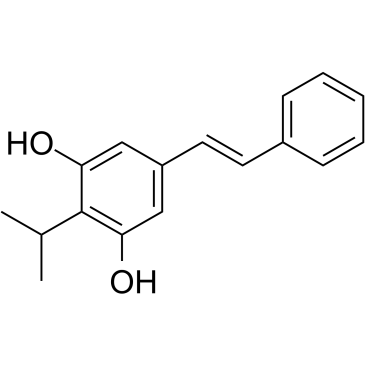| Cas No.: | 79338-84-4 |
| Chemical Name: | 3,5-Dihydroxy-4-isopropylstilbene |
| Synonyms: | WBI-1001;WB-1001;Tapinarof;GSK2894512;GSK-2894512;GSK 2894512 |
| SMILES: | C(/C1=CC=CC=C1)=C\C1=CC(O)=C(C(C)C)C(O)=C1 |
| Formula: | C17H18O2 |
| M.Wt: | 254.329 |
| Sotrage: | 2 years -20°C Powder, 2 weeks 4°C in DMSO, 6 months -80°C in DMSO |
| Publication: | [1]. Smith SH, et al. Tapinarof Is a Natural AhR Agonist that Resolves Skin Inflammation in Mice and Humans. J Invest Dermatol. 2017 Oct;137(10):2110-2119. |
| Description: | Tapinarof is a natural aryl hydrocarbon receptor (AhR) agonist with an EC50 of 13 nM. |
| In Vivo: | Tapinarof acts through AhR to reduce inflammation in IMQ-treated mice. AhR-sufficient mice on a C57Bl/6 background exhibit a reduced clinical score after treatment with Tapinarof or 6-formylindolo(3,2-b)carbazole (FICZ). In contrast, AhR KO mice do not respond to the anti-inflammatory effects of Tapinarof. FICZ is used as a comparator in these studies and yields similar results, with dramatically reduced inflammatory responses in wild-type, but not AhR KO mice[1]. |
| In Vitro: | Tapinarof activates the AhR pathway through direct binding. Tapinarof dose-dependently induces nuclear translocation of AhR in immortalized keratinocytes (HaCaT) (EC50=0.16 nM)[1]. |






















